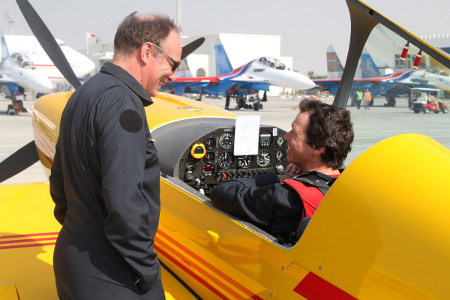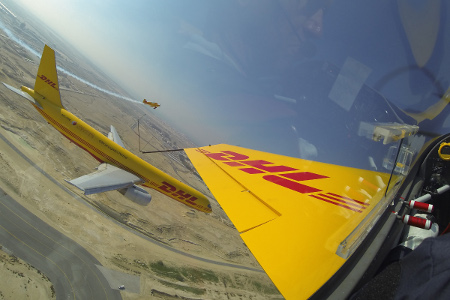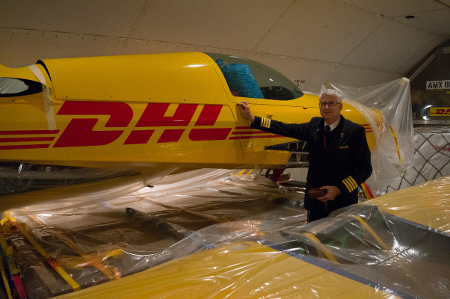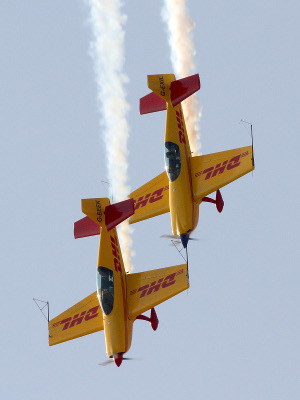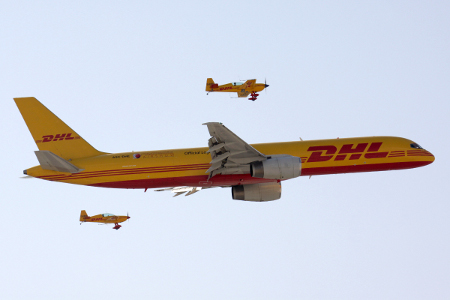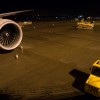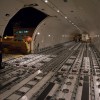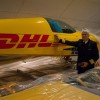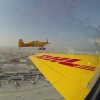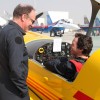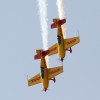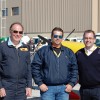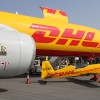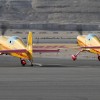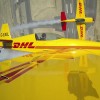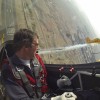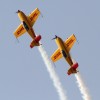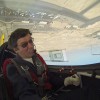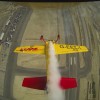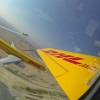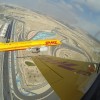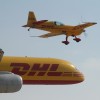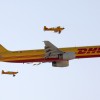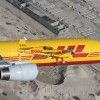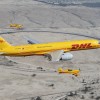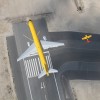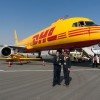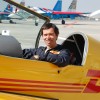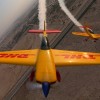The DHL Aviation Display Team
Displaying at the 2014 Bahrain Airshow with the DHL Aviation Display Team, flying in formation with their Boeing 757, was an unforgettable experience. Karl Drage, of Global Aviation Resource, attended the show and captured some fantastic air to air shots of the formation. He also interviewed us post show. The following is a version of the feature he first published in Global Aviation Magazine.
Debuting amongst an assortment of rather more established display acts at the 2014 Bahrain International Airshow (BIAS), held at Sakhir Air Base, was the DHL Aviation Display Team – bringing together a rather unusual formation of a Boeing 757 with single examples of the Extra 200 and Extra 300 aircraft types.
We have occasionally seen solo displays by a DHL 757 or 767 freighter at UK air shows, but what was truly unique was seeing a pair of light-aerobatic types flying in formation with the big jet, separated by a matter of metres off each wing tip. It is claimed that at BIAS 2014 this was the first time such a display has been performed, anywhere in the world.
The Extras, forming The DHL Aerobatic Team and sporting the trademark yellow and red DHL corporate livery, were flown by British aerobatic pilots Adrian Willis in two-seat Extra 200 G-EEEK and Chris Burkett in single-seat Extra 300S G-EXIL. Not only was BIAS 2014 the first time that they would fly together with the 757, it was also the first time that they would display together for the public in DHL colours.
Adrian Willis (Extra 200) and Chris Burkett (Extra 300S)
Adrian has been flying since the age of eight, having started out on gliders. After a decade in the British Army Parachute Regiment, Adrian changed services and set out on a professional flying career with the Royal Air Force, flying types such as the Hawk, Hunter and Canberra. After his military career, Adrian ran a successful multinational IT company before setting up the British Aerobatic Academy where he acts as chief flying instructor.
Chris, meanwhile, first caught the aerobatics bug in his youth, flying a de Havilland Chipmunk. For the last decade his focus has been advanced aerobatics, firstly in a Pitts Special and since 2008 in an Extra 300S, winning several trophies in aerobatic competitions. He’s held a UK CAA Display Authorisation since 2006, operating as G-Force Aerobatics. He’s perhaps best known amongst the airshow-going public for a unique routine he flies alongside a 40% scale radio-controlled model of the Extra.
Away from flying, Chris runs a company that develops aerodynamic software for the design of wings. Somewhat ironically, the technology is used most frequently by Formula One racing teams to keep their cars welded to the track when taking corners at high speed!
The DHL Boeing 757
Whilst the UK arm of DHL, DHL Air, has operated the Boeing 757-200F since January 2001, DHL Aviation in the Middle East only introduced the type in late 2011 in order to replace its ageing fleet of Boeing 727 freighters. Three 757s currently service the DHL Express Middle East/Africa network from Bahrain, flying to destinations like Dubai, Kuwait, Beirut, Riyadh and Asmara.
Fitted with a glass cockpit and powered by two Rolls-Royce RB211 engines, the type can carry payloads of up to 32,000kg for over seven hours or 3,000 nautical miles. Measuring some 47 metres long and with a wing span of 38 metres, the 757 weighs 53,000kg empty, a mere 52,000kg+ more than the Extras flown by Adrian and Chris!
At the controls of the 757 were Captain Chris Rabie – DHL Aviation, Director of Flight Operations – and Captain Roger Ware – DHL Aviation, Flight Training Manager. Acting as Safety Pilot was First Officer Chris Dodwell.
Chris Rabie’s flying career began in 1989 in southern Africa where he flew for a number of airlines before joining DHL Aviation in 2004 on the Boeing 727. In total he has 11,500 flying hours and has been active on the 757 fleet since its introduction in Bahrain.
Roger has been with DHL Aviation for two years, prior to which he flew for a UK-based passenger carrier and instructed on the 757 and 737. He has 5,500 hours total time, 4,000 of which are on the 757. He is also a Bahraini BCAA and UK CAA approved examiner on the type.
The DHL Aviation Display Team
Malcolm Macbeth, DHL Aviation VP Middle East and Africa, explained why the organisation had decided to take such an active part in the flying display at BIAS 2014:
“This year for the first time, DHL took on the role of Official Logistics Partner for the 2014 Bahrain International Airshow. This entailed coordinating and moving all the airshow material arriving in Bahrain by road, sea and air – from the seaport, road border and airport – to Sakhir Air Base and then distributing the material to the exhibition halls and chalets. After the show all the material then had to move back home or onto the next airshow – the main one being Hyderabad in India.
“Bahrain is the home of DHL and the central platform for our air operations in the Middle East. DHL Aviation have been flying dedicated cargo flights to and from Bahrain since 1979 when a Fokker F27 flight was inaugurated between Bahrain and Riyadh – so this year is our 35th anniversary of uninterrupted operations in Bahrain. With such a presence in the country and the added participation from being the Official Logistics Partner, we felt it important to give something back to the community at such a national and internationally significant event.
“In previous years we have had aircraft in the static display and simple flybys of DHL and DHL affiliated airlines. We wanted to put on more of a show than just that and give something back to the community in terms of putting on a spectacle. We had a few thoughts but with little traction coming from them. That’s when Chris and Roger came to me with their idea of combining a B757 display with formation aerobatics!”
“We got the green light in September”, Adrian confirms, “and we needed somebody who not only was up to the flying challenge but was an excellent team player and somebody you would want to be in business with; Chris (Burkett) was the top candidate”.
Getting to Bahrain
With both Adrian and Chris’ aircraft based at Little Gransden near Cambridge, the pair would require some assistance to complete the near 4,000 mile journey to Bahrain, as Chris explains:
“Our Bahrain adventure started in a wet and windy Leicester, where we disassembled the Extras with the help of our engineer Mark Davies and his team at Swiftair. They were collected by DHL and taken to their UK hub at East Midlands Airport, for a flight on a DHL/Aerologic Boeing 777 to Bahrain, via Leipzig.
“This really is the five star option when it comes to shipping your precious cargo, and we are immensely grateful to all at DHL UK who helped to arrange this. We were able to accompany the aircraft onboard ourselves, which was fascinating in itself. Having the DHL Extras as cargo created quite a lot of interest, not least from our 777 captain!
“On arrival in Bahrain we were able to benefit from the great support of DHL Aviation EEMEA which has its regional base at Bahrain International Airport, and we rebuilt the Extras in the DHL hangar there before flying them down to Sakhir Air Base, home of the airshow.”
The Routine
The overall DHL Aviation Display Team routine comprised four distinct elements, starting with the paired Extra sequence that, for large portions, saw Chris’propeller sitting just off the back of Adrian’s aircraft as they flowed through a series of loops, half Cubans and an upwards quarter clover.
Adrian describes his role as formation lead as “putting on a great show, and keeping everyone safe”. He is responsible for positioning the display so the crowd can see it best. “This involves compensating for wind and making sure we don’t upset the display director by crossing the display line. The figures have to be flown very smoothly and predictably and lines between figures must be minimised to maintain excitement and ensure a compact display. This means that corrections need to be small and constant.
“The mirror half Cuban at the start, flying towards the crowd and pushing from 200’ is a good starting figure for many reasons, but from a positioning standpoint it ensures lead (inverted) has an excellent view.
“While No.2 is focussed entirely on the lead aircraft, I am completely responsible for making sure Chris doesn’t hit the ground. As lead I am also responsible for co-ordinating all the opposition manoeuvres while Chris is responsible for avoiding action. The performance disparity between the two Extras does demand that we carefully brief beforehand because the shape of our opposing figures does change slightly according to wind”.
For Chris, the picture is quite different:
“There are times, certainly earlier on during training, when the role of No.2 feels akin to grabbing hold of the tail of a tiger and trying hard not to let go – knowing that if you do there are ‘teeth’ at the other end!
“Predictability and smoothness from Lead is essential, and if both members are working up together the learning curve is steep. A lot of it boils down to confidence: delaying for a split second is not an option – formation manoeuvres need to be initiated simultaneously and this requires great faith in Lead.
“One of the additional challenges we have had is displaying in dissimilar types – an Extra 200 with 200hp and an Extra 300S with 300hp. The complication is flying formation aeros in aircraft of different weights, inertias, wing loadings, power and throttle response. Thankfully, with the 200 as Lead and the 300S as No.2, these differences proved manageable.
“Their wings are almost identical so aerodynamically they are matched, and if Lead flies around on full throttle No.2 is still able to keep up!
“Aerobatic manoeuvres which are straightforward as a solo require a great deal of practice to perfect in formation. For example, a half-cuban turnaround figure, which includes a downward rolling exit from a loop; No.2 has quite a tough job flying a skidding, barrelled, half roll around the axial roll flown by Lead – it feels extremely unnatural until you get used to it!
“The formation break and opposition pass are always fun to fly. The break, which we execute heading towards the crowd, is an 8g pull onto the display axis from a stepped-back line abreast. During one particular practice for the Bahrain show, I had my neck angled a little too much to one side to sight Lead, and during the pull with insufficient bracing my head snapped backwards under the g and I heard and felt my neck make some nasty cracking noises. Jamie Norris (The RAF’s 2013 Eurofighter Typhoon display pilot) prescribed a hard bed and no pillow – several weeks later and my neck is still sore!
“After an opposition pass the tricky bit is joining the formation back up again efficiently. There are two key ingredients here – timing and practice! After a few more formation figures we pull into a push/pull humpty bump ‘burst’ – which gives us sufficient separation in trail for Lead to break whilst No.2 commences a couple of minutes of solo aerobatics.
The second element of the routine was Chris’ solo. Whilst Chris is performing, the DHL 757 left its hold and commenced an orbit a mile downwind. This also gave Adrian some additional time to pre-position the lower-powered Extra 200 for a join-up with the 757.
“The Extra 300S is such a potent aerobatic performer that it is nice to showcase a few of its talents, for instance gyroscopic figures – ‘tumbles’ off various lines.”
Once Chris had completed his solo, he too headed off to the south to formate with Adrian and the 757.
Safety First
With the Boeing 757 being such a large aircraft it presented some unique challenges and potential pitfalls for the Extras but the rewards were spectacular, as Chris Burkett explains:
“To be able to join up and perform a formation flyby off the wing of a big jet was an enormous thrill – without doubt a highlight of my flying career. This was new territory for all of us, and quite understandably there was a degree of nervousness on the part of the flying display committee, who were aware that prior to Bahrain this had not yet been practised.
“The overriding safety concern involves making absolutely sure that at all times the Extras stay well clear of the trailing wake vortices generated by the big jet. Ironically, the 757 has acquired a reputation for the strength of its wake turbulence. After a number of accidents in the 1990s, involving bizjets crashing on approach after a landing 757, the FAA reclassified the 757 into the ‘heaviest’ category for wake separation rules, along with the much larger 747 and 767. Hence ‘falling behind’ the 757 was not a position that we wanted to get into! Bearing in mind that the overlap of our speed range is narrow – the 757 close to its slowest and the Extra 200 near to its fastest, this was a hazard that we were going to be taking seriously.”
The third part of the set-piece was this formation element, with the 757 leading and the Extras on each wing, Adrian on the port and Chris on the starboard. The culmination of this section of the routine saw the Extras break off upwards at 45 degrees to the horizon.
First Impressions
Chris recalls the first time they formated on the 757:
“Our first flight with the 757 was both memorable and reassuring. Chris (Rabie) and Roger, the 757 crew, are clearly accomplished pilots and their speed control and smoothness were excellent throughout. We were able to join up from a high position, trading height for speed. We made sure that Adrian in the 200 was always on the inside of the turns if orbits were required.
“It was helpful that as a freighter, with no cargo and no seats, and with a modest fuel load, the empty weight of the 757 was kept as low as possible.
“We benefitted from the advice and support of Captain Phil Durnford, Manager Flight Standards with the Bahrain Royal Flight, member of the airshow FCC, and with experience of displaying big jets. Likewise with support from Vic Lockwood and Colin Hague, display director, we were able to construct an integrated Extra plus B757 display slot, with the formation flyby as the centrepiece.”
“Also helpful were Chris (Rabie) and Roger’s experiences of ‘unusual’ 757 ops, for example, hand-flown spiral descents into airfields in Iraq and Afghanistan.
“For us, executing a successful link up and fly-past with Chris (Burkett) and Adrian in their Extras was the key to setting our display apart from the normal jet airliner displays you can see on the air show circuit”, Chris Rabie says. “Planning the synchronisation of all three aircraft took long hours of discussion, simulator training and was refined during some invaluable hands on practice in the days leading up to the show.
“As our fly past with the Extra’s directly followed their display sequence, it was imperative that we were in position with the 757 at the right place, at the right time and flying the correct speed in order to allow the Extra formation to join us seamlessly. This sounds easy, but in reality it was far from that, as we had to bring the aircraft from Bahrain International to Sakhir everyday as it was being used for commercial services around the show slots.
“We soon realised that not beginning our display from Sakhir built in some difficulties that needed managing. To give an example, on one of the show days we pushed back from our stand in Bahrain only to be blocked on the taxiway by an executive jet that had in error pushed back without ATC clearance. This caused a long delay in take-off which could have caused a missed display slot had we not built in some additional time.”
“To enable us to link up with the Extra’s we joined a holding pattern at low level and close to the threshold of the active runway”, Roger explains. “Too close and we would be seen by the crowd and detract from the Extra display, too far and the Extra’s would struggle to join with us. We also needed to know exactly where both Extra’s where at all times in order to adjust our position in the hold, allowing the formation to come together quickly and accurately. Any mistakes at this point would require extended holding time which would have caused a break in the show and an overrun of our allotted slot time.
“To facilitate the formation fly-past with the Extras at low speed”, Chris says, “we had to operate an empty aircraft with only enough fuel to complete the display safely and return to Bahrain. This reduces the normal manoeuvring speeds greatly and, in using approach and landing flap, we were able to operate at the speeds required by the Extras whilst still maintaining an acceptable safety margin. Although using flap reduces the aircrafts manoeuvring speeds, it also induces stronger wake vortices off the wing tips, making the Extras positioning in the ‘wake free’ zone that much more crucial. With some precision flying from Chris and Adrian, the Extras anchored to the B757 flawlessly.
“We really could not have asked for two more professional and diligent aerobatic pilots to have worked with.”
Given how greatly this type of flying differs from the way the 757 is flown on a day-to-day basis, it is interesting to hear Roger describe how it was actually flown:
“Due to the unusual attitudes and manoeuvres required, the entire 757 sequence, including the flypast with the Extras, was entirely hand flown without the aid of the aircraft’s advanced flight management, guidance or autopilot systems. Whilst Chris and I both have considerable experience in hand flying the aircraft, it is certainly not something we do too much of during line operations and so practice was the key to a well executed display.
“Additionally, we carried a safety pilot, First Officer Chris Dodwell, on each flight. Chris did a sterling job throughout and his clear brief was to monitor all the aircraft instrumentation, systems and parameters and call out any height, speed or configuration deviations whilst also acting as a third pair of eyes on the flight deck. “
Admiring the View
Two days prior to the show, photographer Karl Drage was able to fly with Mark Jefferies in his Extra 300L for an air-to-air photo shoot with the DHL formation, capturing some of the memorable images shown here. Some of them were taken inverted, with Karl hanging in the straps. The view from the camera ship was spectacular, but what was it like for Chris and Adrian?
“Formating on the 757 was a magnificent experience. Some of the great photographs really give an impression of the size differential”, Chris says. “Sitting just off the wingtip is extraordinary – the aircraft fills an implausibly wide arc in your field of view. Every time we did this it was awe inspiring – but it is also interesting just how quickly you can get used to it! By our second trip it began to feel like a perfectly natural thing to be doing.”
“From my point of view, it was all about the join up”, Adrian points out. “At times the difference between my maximum straight and level speed and the speed of the 757 was very small. Given the risk of dropping into the wake of the 757, any slight misjudgement would have necessitated pulling away and not being able to rejoin. The join up therefore necessitated starting from 1000’ above the 757 and getting it right first time. On the last display day we had a 1400’ cloud base so had to ask the 757 crew to adjust their hold to 500’ AGL. Not something that most airliners do!”
757 Solo
The concluding element of the display was a five-minute solo from the 757. Roger takes up the story:
“Following the formation flypast with the Extras, Adrian and Chris (Burkett) broke off for landing as we commenced our sequence, which included reversals and tight orbits, culminating in a fast flypast to conclude our display. It was important for us to keep the aircraft as close to the crowd line as possible during our sequence; we had both seen large jet aircraft flying wide circuits and simple flypasts before which inevitably meant periods of boredom for the spectators between each pass. This was something that we definitely wanted to avoid.
“Achieving this close-in display was the greatest challenge for us, as the 757 is a large aircraft which carries a lot of momentum and normally operates at relatively high speeds and altitudes. We realised the key would be to keep the aircraft constantly turning with high bank angles at heights which amplified the visual impact, whilst at all times ensuring that safety margins were built in. The final high speed, low level fly-past led into a full thrust Go-Around manoeuvre with a high nose attitude. I am sure from the ground this must have looked quite impressive to the crowd who are probably more used to seeing large airliners lumbering out of major airports heavily laden with passengers, freight and fuel.”
The BIAS 2014 Experience
For the Extras, whilst Adrian and Chris (Burkett) are by no means unique in terms of being a UK display act performing at a Middle Eastern airshow, getting to debut such a novel act at one must be particularly satisfying.
“The whole Bahrain experience was unforgettable, and we owe thanks to so many people for making this happen”, Chris says.
“Another stand out memory was the flight back to Bahrain International Airport post show. As a final hurrah DHL was able to arrange for us to join up with the 757 via a holding point over the Gulf, and run-in for a formation flyby at the airport. Performing a run and break at 200 feet along the main runway at Bahrain International Airport, with a 757 off our wing, felt a little surreal! It was great to be able to share this experience with our key supporters in DHL.”
“I’d just like to go on record and thank the whole team at DHL Aviation Bahrain, from senior management, all of the flight crew, safety, operations and logistics staff, through to everyone in engineering who helped us – some in a very ‘hands on’ role helping to disassemble and reassemble the Extras.
“DHL in the UK also provided great support and performed a first class service in arranging the air freighting of the aircraft to and from Bahrain.
“Thanks also to our engineer Mark Davies and members of the other display acts in Bahrain, who gave good company and mutual support, in particular the Huawei Twister Duo, Mark Jefferies and all of the BreitlingWingwalker team. Mention should also go to Sarah Harding, show organiser, and her colleagues, who did a great job and managed to stay calm and unflappable throughout. Grateful thanks also to our Display Authorisation Examiner Brian Lecomber, for sharing some sage advice drawn from a lifetime of formation aerobatic displays.”
From the DHL side, the message was equally upbeat, as Malcolm Macbeth explained:
“The show turned out to be a massive success with the airshow significantly larger than previous years and over 50,000 people present in the trade and public viewing areas across the three days. We have had many compliments after the show on how the DHL presence stood out and that the DHL Extra formation was one of, if not the best act of the day and our participation was much appreciated.”
Richard Gale, DHL Aviation Air Capacity Sales Director, added: “Brand exposure is of huge importance. From an Aviation Commercial perspective, having the ability to showcase our brand, whilst having our customers present to share the experience, allowed us to recognise their contributions and discuss future development and opportunity. The DHL Aviation display at the 2014 Bahrain International Airshow demonstrated to our customers our can-do attitude.”
Everyone hopes that this will not be the last we see of this unique display. Their performance at Bahrain International Airshow 2014 was very well received, and discussions are underway to bring the DHL Team to more of the major shows in future.




